运动营养学 英文
营养学英语

营养学英语营养学英语是:nutriology。
营养学是研究食物与人体之间的关系以及饮食对人体健康的影响的学科。
营养学的研究对象包括营养素、饮食习惯、食品与食品成分等。
今天我们就来了解一些常见的英文营养学术语。
1. Nutrition 营养Nutrition is the science of how food affects the body. 营养学是研究食物对身体的影响的科学。
2. Nutrient 营养素Nutrients are substances in foods that are essential to the body's functioning and maintenance. 营养素是食物中对人体正常功能和维护必须的物质。
3. Macronutrient 大量营养素Macronutrients are nutrients that the body needs in large amounts. This includes carbohydrates, proteins, and fats. 大量营养素是身体需要摄入的数量较多的营养素,包括碳水化合物、蛋白质和脂肪。
4. Micronutrient 微量营养素Micronutrients are nutrients that the body needs in smaller amounts. This includes vitamins and minerals. 微量营养素是身体需要少量摄入的营养素,包括维生素和矿物质。
5. Calories 卡路里Calories are a unit of energy that is found in food. 卡路里是食物中的能量单位。
6. Carbohydrate 碳水化合物Carbohydrates are a macronutrient that provides the body with energy. 碳水化合物是一种大量营养素,能够为身体提供能量。
运动营养学论文
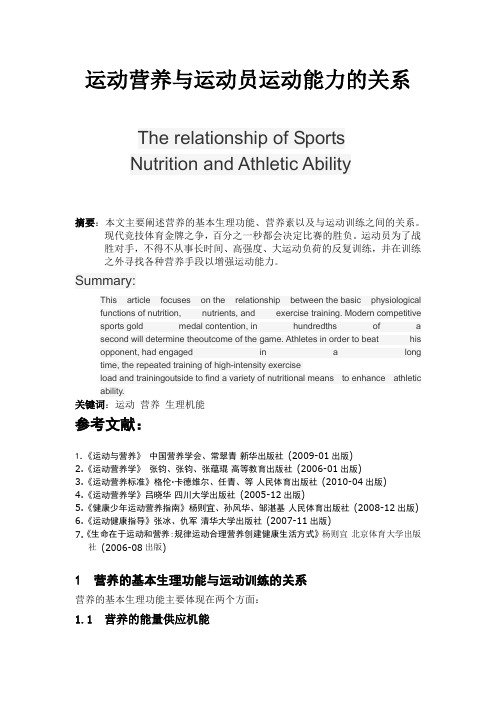
运动营养与运动员运动能力的关系The relationship of SportsNutrition and Athletic Ability摘要:本文主要阐述营养的基本生理功能、营养素以及与运动训练之间的关系。
现代竞技体育金牌之争,百分之一秒都会决定比赛的胜负。
运动员为了战胜对手,不得不从事长时间、高强度、大运动负荷的反复训练,并在训练之外寻找各种营养手段以增强运动能力。
Summary:This article focuses on the relationship between the basic physiological functions of nutrition, nutrients, and exercise training. Modern competitive sports gold medal contention, in hundredths of a second will determine theoutcome of the game. Athletes in order to beat his opponent, had engaged in a long time, the repeated training of high-intensity exerciseload and trainingoutside to find a variety of nutritional means to enhance athletic ability.关键词:运动营养生理机能参考文献:1.《运动与营养》中国营养学会、常翠青新华出版社(2009-01出版)2.《运动营养学》张钧、张钧、张蕴琨高等教育出版社(2006-01出版)3.《运动营养标准》格伦·卡德维尔、任青、等人民体育出版社(2010-04出版)4.《运动营养学》吕晓华四川大学出版社(2005-12出版)5.《健康少年运动营养指南》杨则宜、孙风华、邹湛基人民体育出版社(2008-12出版)6.《运动健康指导》张冰、仇军清华大学出版社(2007-11出版)7.《生命在于运动和营养:规律运动合理营养创建健康生活方式》杨则宜北京体育大学出版社(2006-08出版)1 营养的基本生理功能与运动训练的关系营养的基本生理功能主要体现在两个方面:1.1 营养的能量供应机能营养是指机体从外界环境中摄取物质,通过自身的消化,吸收及利用以维持生存和健康的整个过程。
中英文--西医营养科术语英文翻译
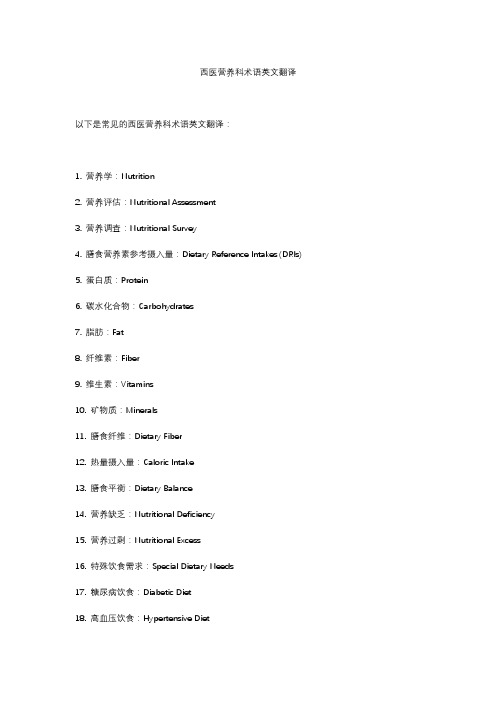
西医营养科术语英文翻译以下是常见的西医营养科术语英文翻译:1. 营养学:Nutrition2. 营养评估:Nutritional Assessment3. 营养调查:Nutritional Survey4. 膳食营养素参考摄入量:Dietary Reference Intakes (DRIs)5. 蛋白质:Protein6. 碳水化合物:Carbohydrates7. 脂肪:Fat8. 纤维素:Fiber9. 维生素:Vitamins10. 矿物质:Minerals11. 膳食纤维:Dietary Fiber12. 热量摄入量:Caloric Intake13. 膳食平衡:Dietary Balance14. 营养缺乏:Nutritional Deficiency15. 营养过剩:Nutritional Excess16. 特殊饮食需求:Special Dietary Needs17. 糖尿病饮食:Diabetic Diet18. 高血压饮食:Hypertensive Diet19. 低钠饮食:Low Sodium Diet20. 低脂饮食:Low Fat Diet21. 素食饮食:Vegetarian Diet22. 全营养饮食:Complete Nutrition Diet23. 禁食:Fasting24. 口服营养补充剂:Oral Nutritional Supplements25. 管饲营养:Tube Feeding26. 强化食品:Fortified Foods27. 纯化食品:Purified Foods28. 食物过敏:Food Allergies29. 食物不耐受:Food Intolerances30. 肠内营养:Enteral Nutrition31. 肠外营养:Parenteral Nutrition32. 有机食品:Organic Foods33. 无麸质食品:Gluten-free Foods34. 天然食品:Natural Foods35. 低糖食品:Low-sugar Foods36. 高纤维食品:High-fiber Foods37. 低卡食品:Low-calorie Foods38. 儿童营养:Childhood Nutrition39. 孕妇营养:Pregnancy Nutrition40. 老年人营养:Senior Nutrition。
运动营养学教学大纲知识分享
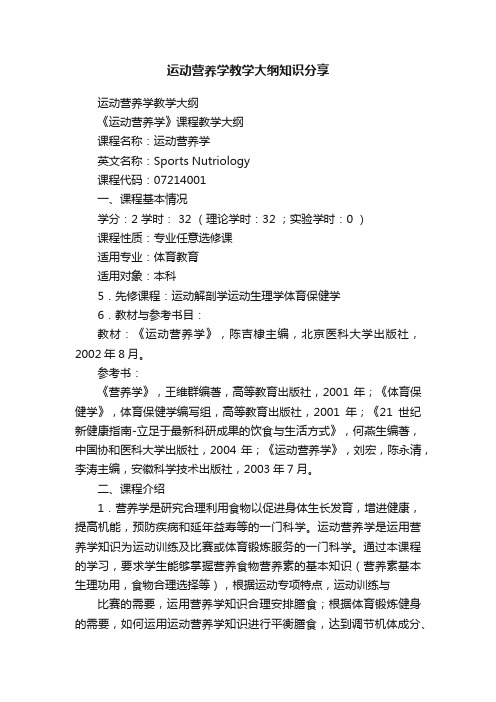
运动营养学教学大纲知识分享运动营养学教学大纲《运动营养学》课程教学大纲课程名称:运动营养学英文名称:Sports Nutriology课程代码:07214001一、课程基本情况学分:2 学时: 32 (理论学时:32 ;实验学时:0 )课程性质:专业任意选修课适用专业:体育教育适用对象:本科5.先修课程:运动解剖学运动生理学体育保健学6.教材与参考书目:教材:《运动营养学》,陈吉棣主编,北京医科大学出版社,2002年8月。
参考书:《营养学》,王维群编著,高等教育出版社,2001年;《体育保健学》,体育保健学编写组,高等教育出版社,2001年;《21世纪新健康指南-立足于最新科研成果的饮食与生活方式》,何燕生编著,中国协和医科大学出版社,2004年;《运动营养学》,刘宏,陈永清,李涛主编,安徽科学技术出版社,2003年7月。
二、课程介绍1.营养学是研究合理利用食物以促进身体生长发育,增进健康,提高机能,预防疾病和延年益寿等的一门科学。
运动营养学是运用营养学知识为运动训练及比赛或体育锻炼服务的一门科学。
通过本课程的学习,要求学生能够掌握营养食物营养素的基本知识(营养素基本生理功用,食物合理选择等),根据运动专项特点,运动训练与比赛的需要,运用营养学知识合理安排膳食;根据体育锻炼健身的需要,如何运用运动营养学知识进行平衡膳食,达到调节机体成分、促进身体机能提高等健康目的。
2.运动营养学是体育教育专业的一门专业任意选修课,其相关基础理论课程是运动解剖学、运动生理学、运动生物化学、运动生物力学等。
3.通过教学使学生掌握运动营养学的基本理论、基本知识和基本技能,为今后从事体育教学、训练、比赛及饮食防治某些常见病等方面发挥应有的作用。
教学中要以启发式讲授为主,结合问题讨论、自学指导等方法进行教学。
教学手段上采用多媒体辅助教学。
三、课程内容、学时分配及教学基本要求绪论(总2学时)(一)教学内容:知识点:食品、营养学、运动营养学的概念、任务,营养和健康的关系,运动营养与体育运动的关系,运动营养学发展概况教学重点:营养学、运动营养学的概念,营养与健康的关系教学难点:合理营养对机体的影响(二)教学基本要求:掌握营养学、运动营养学的概念内容及任务,了解运动营养学学科的发展任务,掌握营养与运动的关系。
《运动营养学》课件

合理的营养摄入有助于维持良好的免疫系 统和代谢状态,预防慢性疾病和提高整体 健康水平。
运动营养学的发展历程
起源
运动营养学起源于古代奥运会,那时运 动员通过特殊的饮食来增强体能和表现
。
专业化发展
20世纪70年代,随着竞技体育的迅速 发展,运动营养学逐渐成为一个专业
领域。
初步发展
20世纪初,随着科学研究的进步,人 们开始系统地研究运动与营养之间的 关系。
运动中营养补充
水分补充
运动中应定时补充水分, 以维持身体水分平衡,预 防脱水。
能量补充
运动中适时补充能量,如 运动饮料、能量棒等,有 助于维持运动表现和预防 疲劳。
电解质补充
运动中出汗会导致电解质 流失,适时补充电解质, 如盐丸、镁丸等,有助于 维持身体正常生理功能。
运动后营养补充
蛋白质补充
运动后及时补充蛋白质,如鸡胸肉、鱼、豆腐等 ,有助于促进肌肉恢复和生长。
饮食建议
保持均衡饮食,多吃蔬菜、水果、全谷类食物和富含蛋白质的食物 ,避免过度摄入糖分和高热量食物。
老年人
营养问题
老年人消化吸收能力下降,容易发生营养不良、骨质疏松等问题 。
运动营养补充
适量补充蛋白质、钙、维生素D等有助于维持肌肉和骨骼健康。
饮食建议
少量多餐,选择易消化、营养丰富的食物,增加蔬菜、水果的摄 入,避免高脂肪、高糖食物。
运动营养学
目 录
• 运动营养学概述 • 运动与能量消耗 • 运动与营养需求 • 运动营养补充策略 • 特殊人群的运动营养学 • 运动营养学实践与应用
01
CATALOGUE
运动营养学概述
定义与特点
定义
运动营养学是研究运动与营养之间相 互关系,以及如何通过合理营养支持 运动能力的科学。
运动营养学基础(通用)

运动营养学基础(通用)第一篇:运动营养学基础(通用)CORE FITNESS 健身初阶-运动营养学基础(通用)本篇只对运动营养学基础及其应用做浅谈,以解决绝大部分实际操作所产生的疑问。
对于深层次的原理及应用不做解答。
前言人体所需的营养素共有6种,分别为碳水化合物,蛋白质,脂类,矿物质,维生素和水。
其中碳水化合物、蛋白质和脂肪在膳食中占比很大,故称之为宏量营养素。
维生素和矿物质在膳食中占比较少,故称之为微量营养素。
营养素和食物的关联是什么?举例说明 100g熟米饭(碳水来源)含有25g碳水化合物因此饮食计划中的营养素含量并不是实际食物的重量。
热量单位:kcal(简称大卡)和 kJ(简称千焦)换算: 1kcal=4.184kJ CORE FITNESS 三大宏量营养素1.碳水化合物:人体最直接同时也是最主要的能量来源。
每1g碳水化合物含有4kcal能量。
存在的形式:分别是单糖、双糖、多糖以及纤维素。
其中只有纤维素(膳食纤维)是人体所无法吸收的,但由于它促进消化吸收的功能性,每日至少应保证摄入30~40g的膳食纤维。
膳食纤维大量存在于蔬菜当中,因此每日要保证一定量的蔬菜摄入。
来源:在生活中就是我们所说的主食、糖、水果这些,值得注意的是有些淀粉含量高的蔬菜,也应视为碳水来源,如薯类、藕、山药、南瓜等。
GI指数:反应的是食用某种食物之后会引起多大的血糖反应。
如果GI很高,说明消化吸收很快,立刻会造成大幅度的血糖升高曲线,但问题是不会很持久(很快就饿了)。
而低GI食物,如薯类、山药、南瓜、燕麦等我们称之为慢碳。
消化吸收很平缓,不会引起突然的血糖升高,但续航能力非常强。
2.蛋白质:组成人体一切细胞、组织的重要成分。
机体所有重要的组成部分都需要有蛋白质的参与。
可以提供能量。
每1g蛋白质含有4cal能量。
存在的形式:多种不同类型的氨基酸脱水缩合形成互不相同的蛋白质。
摄入的蛋白质在体内分解成各种氨基酸,用以合成各种人体所需蛋白质(修复肌肉)。
《运动营养学》教学大纲

《运动营养学》教学大纲运动营养学》教学大纲课程编号: 081702 课程名称:运动营养学英文名称:Sport nutriology 课程类型: 选修课总学时:32 讲课学时:32 实验学时:0 学分:2适用对象: 运动训练专业本科先修课程:运动生理学、运动生物化学、运动保健学、运动营养与恢复执笔人:方秋丽审定人:姜大勇一、课程性质、目的和任务运动营养学是高校运动训练专业开设的一门选修理论课,主要目的是介绍营养与各种慢性疾病营的关系及防治原则和方法;运动员的膳食营养特点、常见运动营养补充剂及违禁药物等知识。
具体任务如下:1.通过课堂教学,培养学生的辨证唯物主义观点和求实的科学思维方法。
2.掌握营养与各种慢性疾病的关系及防治原则和方法。
3. 了解不同专项运动员的膳食营养特点。
4. 掌握常见运动营养补剂的使用原则和方法。
5.根据营养学所学知识,指导不同人群的合理膳食。
二、课程教学和教改基本要求在学习完运动生理学、运动生物化学、运动保健学、运动营养与恢复的基础上才能开设学习本课程,拥有相应的教学设备和科研实验设备。
三、课程各章重点与难点、教学要求与教学内容第一章常见慢性病患者锻炼期的膳食营养教学重点与难点:掌握营养与高血压、高脂血症、糖尿病、骨质疏松症及肥胖的关系,掌握锻炼时营养在防治该慢性病中的作用。
教学要求:了解各种慢性疾病的特点、及各种慢性病的保健食谱,掌握营养与各种慢性疾病的关系及防治措施。
教学内容:第一节高血压患者锻炼期的膳食营养一、营养与高血压(一)高血压1.血压水平的定义和分类2.血压水平的分级标准3.血压测量的最佳时间4.高血压疾病的信号5.高血压的治疗(二)营养与高血压1.高盐饮食与高血压2.高能量饮食与高血压3.食物与药物之间相互作用与高血压二、高血压患者锻炼期的膳食营养安排三、高血压患者常用的保健食谱第二节高脂血症患者锻炼期的膳食营养一、营养与高脂血症1.血脂正常值2.高脂血症的分类3.高脂血症的症状4.高脂血症的治疗(二)营养与高脂血症1.脂类2.糖类与膳食纤维二、高脂血症患者锻炼期的膳食营养安排三、高脂血症患者常用的保健食谱第三节糖尿病患者锻炼期的膳食营养一、营养与糖尿病(一)糖尿病1.糖尿病的诊断2.糖尿病的分类3.糖尿病的典型症状4.造成糖尿病的环境因素(二)营养与糖尿病1.蛋白质2.脂肪3.糖类4.膳食纤维5.微量元素6.维生素7.其他膳食成分二、糖尿病患者锻炼期的膳食营养安排三、糖尿病患者常用的保健食谱第四节骨质疏松症患者锻炼期的膳食营养一、营养与骨质疏松症(一)骨质疏松症1.诊断2.骨质疏松症的分类3.骨质疏松症的症状4.老年人治疗骨质疏松的三大误区(二)营养与骨质疏松症1.钙2.VD3.磷4.镁5.微量元素6.蛋白质7.维生素8.植物激素二、骨质疏松症患者锻炼期的膳食营养安排三、骨质疏松症患者常用的保健食谱第五节肥胖症患者锻炼期的膳食营养一、营养与肥胖(一)肥胖1.评定标准2.肥胖的分类3.肥胖的危害(二)营养与肥胖的关系1.能量代谢与肥胖:糖代谢、脂肪代谢2.膳食结构与肥胖3.膳食纤维与肥胖4.几种能预防肥胖的中草药二、肥胖症患者锻炼期的膳食营养安排1.限制膳食热量2.适当的营养素分配比例3.改变饮食习惯4.注意多饮水5.控制饮食应持之以恒6.营养干预三、肥胖症患者常用的保健食谱复习题1.试述高血压疾病的信号以及高血压患者锻炼后的膳食营养安排2.试述高脂血症的危害、高脂血症锻炼后的膳食营养安排3.试述糖尿病的可能病因及营养在防治糖尿病中的作用4.试述糖尿病锻炼期的膳食营养安排5.试述骨质疏松症锻炼期的营养安排6.试述肥胖的危害以及能量与肥胖的关系7.试述营养在减肥中的作用以及肥胖症患者锻炼期的膳食营养安排第二章运动员膳食营养教学重点与难点:重点讲解不同项群运动员训练的生理学特征和膳食营养特点,难点掌握运动员训练和比赛不同阶段的膳食营养措施。
《运动营养学》ppt 第1章 运动营养基础

食品,如馒头、面条; 动物担心、肝及猪肉的
乳 酸 堆 积 ; 食 欲 的 增 进 剂 :欲差、恶心、忧郁、mg/d 因VB1可抑制乙酰胆碱 急躁、沮丧、麻木、训 练
期
3-5
肌肉的主要成分 增加机体的能量储藏
• 运动与营养素(nutrients)
3、运发动的蛋白质需要量 日本及东欧:运发动需2g/kg体重以上的蛋白
质;西欧:1.4g/kg体重的蛋白质即可满足运发动 的需求;我国:蛋白质供给量应为总能量的 12~15%,约为1.2~2.0g/kg体重。
• 运动与营养素(nutrients)
食品,如馒头、面条; 动物担心、肝及猪肉的
积;食欲的增进剂:因VB 1可抑制乙酰胆碱的分解,
忧郁、急躁、沮 丧、麻木、心电
mg/d 训练
期
3-5
其 稳 定 .但在碱性条件下 受热极易被破坏,如蒸
瘦肉及蛋类较多。
而因刺激肠胃蠕动,改善了 图异常等;
mg/d;
馒头、煮稀饭不宜放碱;
食欲;重体力劳动的补充剂。
1、分类
单糖
双糖
常见的是含有6个碳原 子的葡萄糖、果糖、 半乳糖及单糖的衍生
物,如山梨醇
常见的双糖有蔗糖、 麦芽糖和乳糖
多糖
多糖无甜味,不溶于 水。其中,淀粉是多 糖在植物中的主要存
在形式
• 运动与营养素(nutrients)
2、碳水化合物的生物学功能 供给能量
构成机体的重要物质 节约蛋白质 抗生酮作用 解毒 作用 增强肠道功能
促进脂溶性维生素的吸收、增加食欲和饱腹感
• 运动与营养素(nutrients)
2、脂类的摄入与身体的健康
肥胖
冠心病
癌症
免疫功 能下降
运动与营养 英文
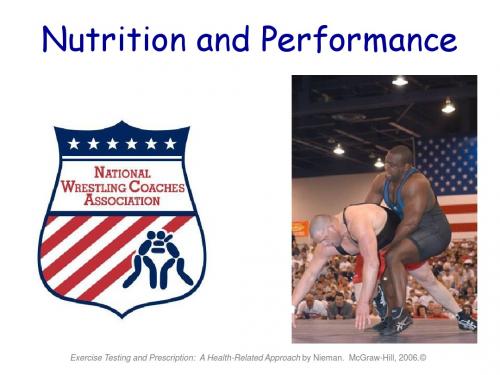
least 30
minutes of moderate-intensity physical activity, above usual activity, at work
least 60 to 90
minutes of daily moderate-intensity physical activity while not exceeding
caloric intake requirements. Some people may need to consult with a healthcare provider before participating in this level of activity.
or home on most days of the week. – For most people, greater health benefits can be obtained by engaging in physical activity of more vigorous intensity or longer duration. – To help manage body weight and prevent gradual, unhealthy body weight gain in adulthood: Engage in approximately 60 minutes of moderate- to vigorous-intensity activity on most days of the week while not exceeding caloric intake requirements. – To sustain weight loss in adulthood: Participate in at
英语课程中的营养学与食品科学词汇

英语课程中的营养学与食品科学词汇在学习英语课程时,了解与食品和营养相关的词汇是非常重要的。
本文将介绍一些与营养学和食品科学相关的常用词汇,帮助学生更好地理解和掌握这些概念。
第一部分:营养学1. Nutrition(营养学)- the study of nutrients in food and how the body uses them for growth and health.2. Nutrients(营养素)- substances in food that the body needs to function properly, including carbohydrates, proteins, fats, vitamins, and minerals.3. Carbohydrates(碳水化合物)- the body's main source of energy, found in foods like bread, rice, and pasta.4. Proteins(蛋白质)- essential for building and repairing tissues in the body, found in foods like meat, fish, and beans.5. Fats(脂肪)- provide energy and help with the absorption of fat-soluble vitamins, found in foods like butter, oil, and nuts.6. Vitamins(维生素)- organic compounds that are necessary for normal growth, development, and maintenance of health, found in foods like fruits, vegetables, and dairy products.7. Minerals(矿物质)- inorganic substances that the body needs in small amounts for various functions, found in foods like salt, milk, and meat.8. Fiber(纤维素)- a type of carbohydrate that is not digested by the body but is important for maintaining a healthy digestive system, found in foods like whole grains, fruits, and vegetables.第二部分:食品科学1. Food Science(食品科学)- the study of the physical, chemical, and biological properties of food and the ways in which food is processed.2. Food Safety(食品安全)- the practice of handling, preparing, and storing food in ways that prevent foodborne illnesses.3. Foodborne Illness(食物中毒)- an illness caused by consuming contaminated food or drink, often resulting in symptoms such as nausea, vomiting, and diarrhea.4. Food Additives(食品添加剂)- substances added to food to enhance flavor, texture, appearance, or shelf life, such as preservatives, flavor enhancers, and colorings.5. Food Processing(食品加工)- the transformation of raw ingredients into food products, often involving techniques like cutting, grinding, cooking, and preserving.6. Food Labeling(食品标签)- the information provided on food packaging that includes ingredients, nutritional content, and allergy warnings.7. Organic Food(有机食品)- food that is grown without the use of synthetic fertilizers, pesticides, or genetically modified organisms (GMOs).8. Genetically Modified Organisms (GMOs)(转基因生物)- organisms whose genetic material has been altered in a way that is not naturally occurring, often used in agriculture to improve crop yield or resistance to pests.通过学习以上词汇,学生可以更好地了解与营养学和食品科学相关的概念。
运动营养学课件——第十五讲 运动员的的营养需要特点

一、耐力性项目的营养需要特点
(一)耐力性项目运动能量物质的营养需要特点
1、肌糖原含量减少、体液丢失和体温升高 2、长期从事耐力性项目训练者容易发生缺铁性
贫血 3、耐力性项目运动员首先满足糖类和脂肪等能
量物质的补充,其中糖应占总能量摄入的 60%-70% 4、赛前、赛中和赛后可根据比赛时间长短考虑 补充含糖饮料(但赛前1h内不建议补)。 5、如果饮用含糖饮料的方式补充糖,其浓度不 要超过10%,以免影响胃排空的速度。
(3)不同项目运动时的强度和持续时间所需能 量差异见图7-1,耐力性运动如铁人三项、 长距离自行车和长距离游泳等项目的日能量 消耗较高,而摔跤和舞蹈等项目的日能量消 耗较低。然而,无论运动员从事什么项目, 均是以糖分解代谢所提供的能量比例最高, 脂肪居中,而蛋白质最少。
第二节、不同项群运动员的营养 需要特点
5、体重控制(weight control)——控制饮食饮 水、增加运动消耗以及通过各种物理手段(如 穿着不透气的尼龙运动服运动。桑拿等)乃至 服用药物进行脱水等,其中不乏服用违禁药物。 研究发现,举重运动员在赛前控制体重期间, 应注重合理的营养保障,以免对运动员的身体 健康造成损害。通常情况下,日能量摄入不应 少于6 278 MJ-100 452 MJ且根据举重运动员 的体重和赛前运动量大小酌情增减;在摄入低 能量饮食的同时,适度增加蛋白质(2 g/kg体 重)补充,减少脂肪摄入(14 g/kg体重), 保障充足的无机盐、维生素和微量元素,必要 时可以食用一些专门为举重运动员研制的控减 体重期间使用的平衡营养膳食。但禁止使用利 尿剂和其他一些对运动员身体健康危害较大违 禁药物控减体重。
运动营养学 英语
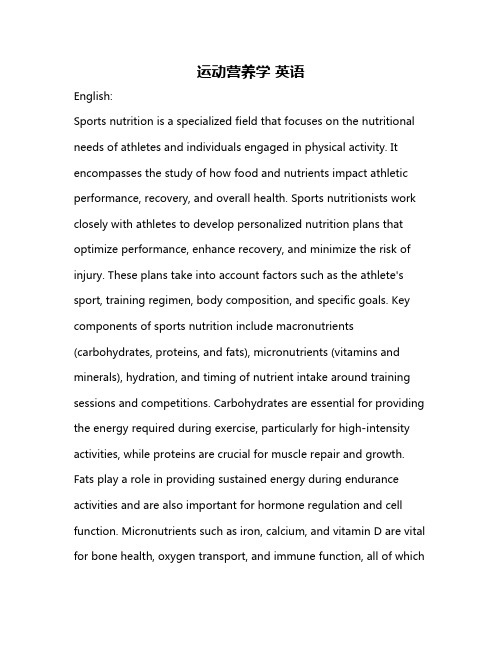
运动营养学英语English:Sports nutrition is a specialized field that focuses on the nutritional needs of athletes and individuals engaged in physical activity. It encompasses the study of how food and nutrients impact athletic performance, recovery, and overall health. Sports nutritionists work closely with athletes to develop personalized nutrition plans that optimize performance, enhance recovery, and minimize the risk of injury. These plans take into account factors such as the athlete's sport, training regimen, body composition, and specific goals. Key components of sports nutrition include macronutrients (carbohydrates, proteins, and fats), micronutrients (vitamins and minerals), hydration, and timing of nutrient intake around training sessions and competitions. Carbohydrates are essential for providing the energy required during exercise, particularly for high-intensity activities, while proteins are crucial for muscle repair and growth. Fats play a role in providing sustained energy during endurance activities and are also important for hormone regulation and cell function. Micronutrients such as iron, calcium, and vitamin D are vital for bone health, oxygen transport, and immune function, all of whichare critical for athletic performance. Proper hydration is essential for maintaining fluid balance, regulating body temperature, and supporting cardiovascular function. Timing nutrient intake before, during, and after exercise can optimize performance and facilitate recovery by providing the body with the necessary nutrients at the right times. In summary, sports nutrition plays a fundamental role in maximizing athletic performance, promoting recovery, and ensuring overall health and well-being for athletes and physically active individuals.中文翻译:运动营养学是一个专门研究运动员和从事体育活动的个体的营养需求的领域。
运动营养学-(运动功能食品与健康)

增肌
选择高蛋白、适量碳水化合物和脂 肪的食物,如牛肉、鸡蛋、全麦面 包等,以满足肌肉生长所需营养。
耐力训练
选择富含碳水化合物的食物,如米 饭、面包、水果和蔬菜等,以补充 能量。
运动前后的饮食搭配
运动前饮食
运动前1-2小时少量进食,选择易 消化、低脂、高能量的食物,如 香蕉、燕麦片、全麦面包等,以 避免运动时能量不足。
提高运动表现
能量补充
运动功能食品富含碳水化合物、蛋白质和脂肪等能量来源,能够 快速补充运动中消耗的能量,提高运动耐力和表现。
增强肌肉力量
运动功能食品中的蛋白质和氨基酸等成分有助于肌肉蛋白质的合成, 增强肌肉力量和耐力。
促进代谢
一些运动功能食品中的成分能够促进脂肪代谢和糖原储备,提高运 动时的能量利用效率和耐力。
抗氧化作用
一些运动功能食品中的抗氧化成分能 够清除运动过程中产生的自由基,减 少氧化应激反应,从而减轻疲劳。
预防运动损伤
提供关节保护
一些运动功能食品中的成分能够提供关节保护,减少运动中的关节磨损和损伤。
增强免疫力
运动功能食品中的维生素、抗氧化剂和其他免疫相关营养素能够增强免疫力,降低感染风险,预防因免疫力下降 导致的运动损伤。
促进肌肉生长与修复
提供必要营养
运动功能食品中的蛋白质、维生素和矿物质等成分能够满足肌肉生长和修复所需 的营养需求。
加速肌肉恢复
一些运动功能食品中的成分能够促进肌肉细胞的修复和再生,加速肌肉疲劳后的 恢复过程。
减轻运动疲劳
补充电解质
运动功能食品中的电解质成分能够补 充因出汗而流失的电解质,维持身体 的正常生理功能,减轻疲劳感。
摔跤吧爸爸关于运动营养学知识的作文
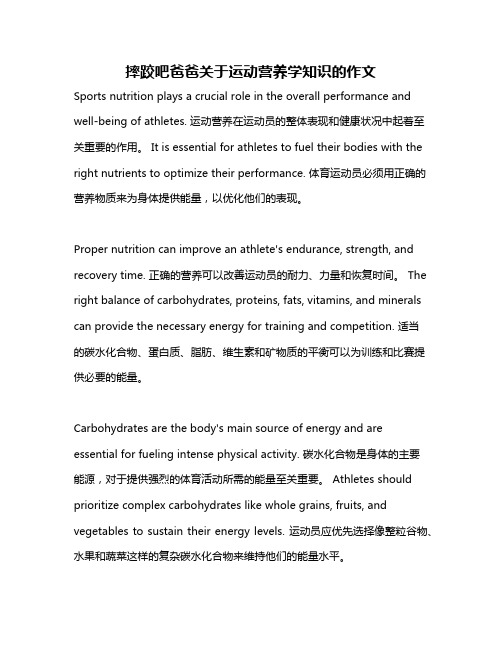
摔跤吧爸爸关于运动营养学知识的作文Sports nutrition plays a crucial role in the overall performance and well-being of athletes. 运动营养在运动员的整体表现和健康状况中起着至关重要的作用。
It is essential for athletes to fuel their bodies with the right nutrients to optimize their performance. 体育运动员必须用正确的营养物质来为身体提供能量,以优化他们的表现。
Proper nutrition can improve an athlete's endurance, strength, and recovery time. 正确的营养可以改善运动员的耐力、力量和恢复时间。
The right balance of carbohydrates, proteins, fats, vitamins, and minerals can provide the necessary energy for training and competition. 适当的碳水化合物、蛋白质、脂肪、维生素和矿物质的平衡可以为训练和比赛提供必要的能量。
Carbohydrates are the body's main source of energy and are essential for fueling intense physical activity. 碳水化合物是身体的主要能源,对于提供强烈的体育活动所需的能量至关重要。
Athletes should prioritize complex carbohydrates like whole grains, fruits, and vegetables to sustain their energy levels. 运动员应优先选择像整粒谷物、水果和蔬菜这样的复杂碳水化合物来维持他们的能量水平。
5.运动营养
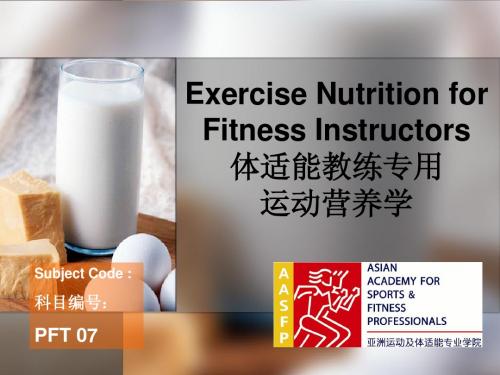
Phospholipids – combination of phosphorus and fatty acid Glucolipids - combination of carbohydrates, fatty acids and nitrogen Lipoproteins - water soluble aggregates of protein with triglycerides, phopholipids, or cholesterol
是脂类物质经水解
所得的产物
Eg: glycerol, fatty 例如: acids, sterols 甘油、脂肪酸、
固醇
Structure of Sterol 固醇结构
Cholesterol 胆固醇
Function: Produce bile acids and hormone Maintain cell function Source : 70% is produced by liver 30% is absorbed from food
Simple Lipids 简单脂质
Monoglycerides - one fatty acid Diglycerides - two fatty acids Triglycerides - three fatty acids > 90% of weight of fat in foods and > 95% of stored fat in the human body are in the form of triglycerides
葡萄糖、果糖和半乳糖 碳水化合物的基本单位
Glucose, Fructose, Galactose Basic unit of Carbonhydrates Primary source of energy for brain & nervous system and muscle
- 1、下载文档前请自行甄别文档内容的完整性,平台不提供额外的编辑、内容补充、找答案等附加服务。
- 2、"仅部分预览"的文档,不可在线预览部分如存在完整性等问题,可反馈申请退款(可完整预览的文档不适用该条件!)。
- 3、如文档侵犯您的权益,请联系客服反馈,我们会尽快为您处理(人工客服工作时间:9:00-18:30)。
294
310
167
185
203
222
240
259
278
296
315
333
352
370
Raquetball Running, 08 mph (7.5 minutes/mile)
185
205
225
246
266
287
308
328
349
369
389
410
274
305
336
366
396
427
458
488
518
Genetics Training Nutrition
and Conditioning
Determinants of the Athlete’s Energy Requirements
During
intense exercise prolonged exercise
Carbohydrate
108
120
132
144
156
168
180
192
204
216
228
240
72
80
88
96
104
112
120
128
136
144
152
160
230
255
280
306
332
357
382
408
433
459
484
510
Carbohydrates
Non-essential nutrient (human body can make sugar) Simple (sugars) and Complex (starches) Major fuel source for exercising muscle Athletes should ingest 6 to10 gm/kg/day
Nutrition and Nutritional Supplements in Sports
Objectives
Increase awareness that nutrition can affect an athlete’s performance Discuss current nutritional recommendations for athletes Review the 1994 Dietary Supplement Health and Education Act
Aerobics step training, 4" step (beginner)
131
145
160
174
189
203
218
232
247Βιβλιοθήκη 261276290
Backpacking
180
200
220
240
260
280
300
320
340
360
380
400
Basketball (game) Bicycling, 10 mph (6 minutes/mile)
198
220
242
264
286
308
330
352
374
396
418
440
112
125
138
150
162
175
188
200
213
225
237
250
Hiking, no load Jogging, 5 mph (12 minutes/mile)
140
155
171
186
202
217
232
248
263
279
Review the Anabolic Steroid Control Act of 2004 Help providers answer questions and address concerns of athletes, parents and coaches
Performance Influencing Factors
stored in muscles and liver (glycogen) is predominant fuel source stores are predominant fuel source
During
Fat
Fitness
Well
level of the athlete
trained endurance athletes burn fat more efficiently, sparing limited glycogen stores
Definition of a supplement Impact of this legislation
Discuss specific nutritional supplements commonly used by athletes
Do they work? Are they safe?
60 to 70% of total calories should come from carbohydrates Complex carbohydrates (starches) are preferable Athletes should consume 25 to 30 gm of carbohydrate for every 30 minutes of exercise Athletes should drink 6 to 8 ounces of water or sports drink for every 10 to 15 minutes of exercise
Active person (endurance athlete)
Underweight person
kg = lbs / 2.2
Activity for 30 min.
90 lbs.
100 lbs. 110 lbs. 120 lbs. 130 lbs. 140 lbs. 150 lbs. 160 lbs. 170 lbs. 180 lbs. 190 lbs. 200 lbs.
Formula for Estimating the Body’s Calorie Requirements
Sedentary person
Weight (kg) x 25 Weight (kg) x 30 Weight (kg) x 40 Weight (kg) x 45
Moderately active person
549
579
610
Soccer Swimming (25 yards/minute) Walking, 3 mph (20 minutes/mile) Weight training (40 sec. between sets)
176
195
215
234
253
273
292
312
332
351
371
390
